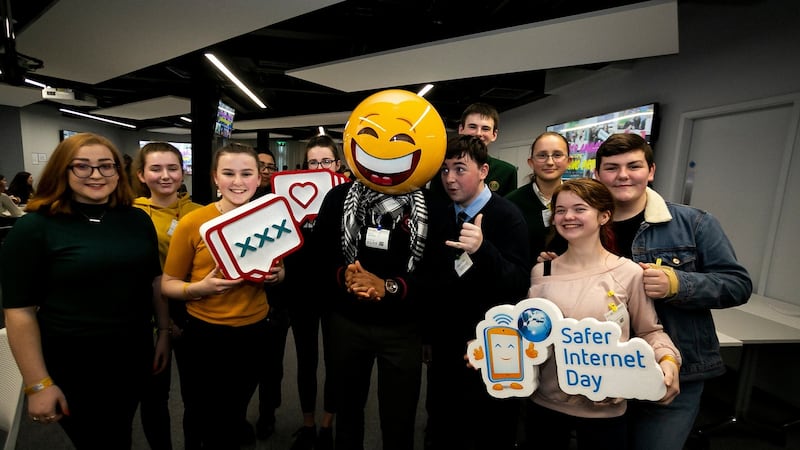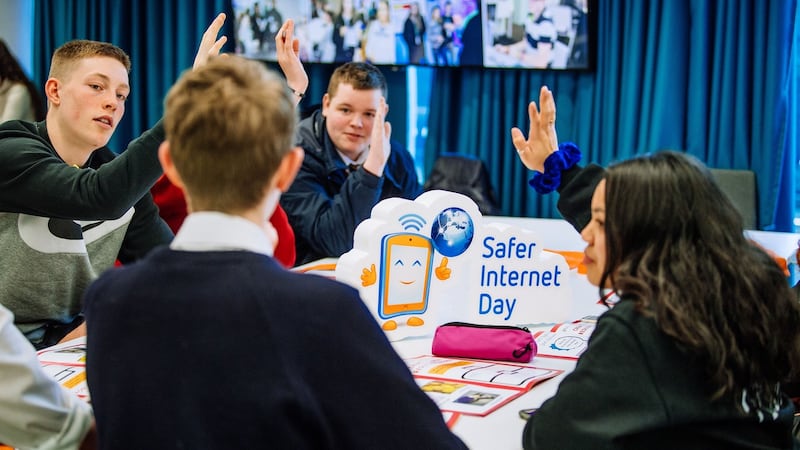Not so long ago, the official advice to young people on staying safe online was to never share images of yourself.
"Today, kids all over the country are posting TikTok videos of themselves dancing in their bedrooms," jokes Erin Barrett, a sixth-year student at Ardscoil Mhuire, Co Limerick.
So it goes online. In an increasingly bewildering media environment, technology changes and new fads replace old ones. It’s hard to keep up – even for young people themselves.


It’s one reason why the latest trend in empowering young people to stay safe online is boosting their overall “digital media literacy” skills.
The phrase is used to cover everything from critical thinking, being aware of echo chambers, spotting fake news online and being alert to how your personal information can be used.
With democracies around the world threatened by the seemingly unstoppable onslaught of false information, these are skills which are increasingly vital in navigating the modern world online.
To mark Safer Internet Day, Webwise – a State-funded internet safety group – is today (February 11th) releasing a free classroom resource on digital literacy for Junior Cycle students called Connected.
This resource tackles online wellbeing, news, information and false information, big data and the data economy, as well as rights online.
Lack the critical skills
While today’s “digital natives” can master devices, experts say they often lack the critical skills to interpret the world around them.
Brian O'Neill, professor of media and communications and director of research at Technological University Dublin, believes the ideal place for digital literacy to be taught is in school.
“Digital literacy encompasses the skills and competencies to be able to operate effectively in the digital environment,” he says.
“It is deliberately quite broadbased: it’s attitudes, values, skills and understanding, so education is the most appropriate place in which to provide that foundation, this digital readiness, for the kind of environment that young people now live in and in which they are developing their own identities and their own future careers.”
Regarding the Connected programme specifically, he believes it is well-curated and will resonate with young people.
The programme touches on digital wellbeing, technical skills and being able to work with technology as well as content issues and awareness of the political environment.
“Webwise have put in good digital skills for living at the starting point, so it’s meaningful for all students, regardless of their own particular disposition – some more creative-oriented, others lean towards the technological end, it will appeal to all,” says O’Neill.
The Connected programme is just one of many available online for use by teachers and their classes (see below).
At Ardscoil Mhuire, the volume of activities planned for Safer Internet Day means it has extended into Safer Internet Week this year.
The school has organised an expo for students. "It's going to be fun and games, it's going to be a lot of information as well but delivered in a very fun and active way," says Patrick Huff, assistant principal at the school.
‘Nana Test’
This includes the “Nana Test”, where a student dresses up as a granny, and students are tested to see if the information they put up online is suitable to show to their granny. If not, the advice is that it shouldn’t be posted.
Huff believes the test is a good way to “urge students to be reflective about their online presence and their online behaviour”.
“I’m there as a facilitator,” says Huff. “The students take the lead, I help them out but it’s very much their vision, and they’re very driven by a sense of inclusion and making sure everybody gets the best out of it. They have cast a wide net, but I have no doubt in their capabilities to achieve what they’ve set for themselves.”
Erin Barrett became involved with Webwise while in transition year through Young Social Innovators, where her class ran a campaign to raise awareness about the implications of teenage ‘sexting’.
Today she is a member of Webwise’s youth advisory panel. Barrett describes the panel as “facilitating synergy between many young people who feel passionately about internet safety education, and provides us [those on the panel] with skills and opportunities to spread awareness on an even wider scale”.
The school has also branched out into the local community, with students due to visit two primary schools to discuss internet safety, addressing topics such as how to do effective research and how to spot false information, and the dangers of echo chambers and filter bubbles.
In the meantime, schools are being encouraged to explore Connected and other resources to boost students’ digital media literacy skills,
If these skills are so crucial, should they be mandatory on the national curriculum for all children?
O’Neill says: “We can always do more. It’s not to say that we haven’t done lots of good things in the past. By developing this resource [Connected] for the Junior Cycle, Webwise are making a very distinctive statement – that students need a strong digital literacy foundation to allow them to develop skills across lots of different domains
As for Barrett, she has come to understand digital literacy as vital to navigating the world online.
‘False information’
“For example, being digital media literate means that you do not instantly believe some of the false information that has come to dominate social media in recent years,” she says.
She believes digital literacy is a vital skill to teach young people, “as technology keeps changing every single day, so it’s so important that we keep informed so that we can make the best decisions online. It’s definitely something that we need to keep on top of, and we need to keep learning and keep informing ourselves about.”
Internet safety and digital literacy : free classroom resources for teachers:
Webwise.ie, the State and EU-funded internet safety awareness centre, has produced a range of classroom resources. Here's a guide to some of the most popular:
Html Heroes: An introduction to the internet
This new SPHE resource has been developed for third- and fourth-class pupils on safe and responsible use of the internet.
There are eight interactive lessons included in the programme such as online gaming, screen time, fake news and online advertising.
[ webwise.ie/html-heroes/Opens in new window ]
Be in Ctrl
This Junior Cycle SPHE resource addresses online sexual coercion and extortion. There are three lesson plans and it is supported by the Garda School Programme.
[ webwise.ie/beinctrl/Opens in new window ]
Lockers
This SPHE resource was developed to engage second- and third-year students on the topic of non-consensual image sharing. There are two short, high-quality animations, six lessons and information for school leaders.
[ webwise.ie/lockers/Opens in new window ]
#UP2US anti-bullying kit
This resource includes activities for addressing bullying, colourful stickers and supplies for creating interactive poster campaigns. Also included is the #Up2Us Anti-Bullying Teachers’ Handbook with Junior Cycle SPHE lesson ideas.
[ webwise.ie/up2us-2/Opens in new window ]
MySelfie and the Wider World
This primary-level anti-cyberbullying teachers’ handbook is an SPHE resource developed to engage fifth- and sixth-class primary school students on the topic of cyber bullying. A series of short animations are the centrepiece of the resource.
[ webwise.ie/teachers/my-selfie/Opens in new window ]
Think B4U Click
Designed for teachers of Junior Certificate CSPE, ThinkB4UClick explores the issue of online privacy in the context of online rights and responsibilities.


















